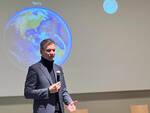“In space you have to become an extraterrestrial, because everything changes: to move you have to use your hands instead of your feet, while those things are used to keep you still. The way one’s companions interpret expression also changes, and the absence of gravity invents a different social.” It is an unstoppable flow of stories Paul Nespolia former ESA astronaut and engineer, is among the guests The second part of the Ugis training day, the Federation of Scientific Journalists, held at Palazzo XNL, in collaboration with the Syndicate of Journalists and the Foundation of the Syndicate of Journalists of Emilia-Romagna and FAST- the Federation of Scientific and Technical Societies, with the valuable support of the Piacenza Foundation and Vigevano. Three missions in which Nespoli participated, for a total of 313 days in space, aboard the International Space Station 400 km from Earth. the first, for 15 days, in 2007. Two more would follow: in 2010, he was aboard the ISS for 157 days; In 2017 there were 139 days.
picture
3 out of 4
A unique experience Nespoli ironically describes. It is possible to grow lettuce in space (“We found out it grows better in violet light”) but not to play cards (“I brought them with me, but as soon as I took them out they flew everywhere”); A place where everything becomes an experience, even oneself. “In our daily routine, similar to a kind of metalworker in space, this includes two and a half hours to devote to physical activity, such as a treadmill, which can only be used by wearing a belt attached to a belt, otherwise it is impossible to run,” Nespoli says. To collect useful data: The absence of gravity affects our bodies, the density of the skeleton as well as vision. The eye loses its spherical shape and the retina can move.” It’s one of the themes that comes into play when it comes to space travel: not just technological pitfalls but also human weaknesses. “The estimated time to Mars is 8-10 months. We don’t know how the human body will react, what it will be like to live together in cramped quarters on a mission that could last up to three years in general.”
“For us astronauts, upon our return from missions, we are expected to spend three weeks recovering, in Houston or other centers, with physicals, exams, and briefing activities. For example, I’ve been having circulation problems, with swollen ankles for a while. Six months. But the biggest difficulty, getting back on the ground, is being able to stand upright and balanced. Getting back to normal takes time.” Which is not difficult to understand for those who alternated work as a “metallurgist in space” with phone calls to the President of the Republic and the Pope, and had the opportunity to “look at the world from a very special porthole.” In a few minutes, the Earth goes from sunrise to sunset, from one country to another, at a speed of 8 kilometers per second. “During my first mission, I took 27,000 photos,” he says, “and reached 500,000 photos the last time. But what made me think was the vision, even when the sun disappears behind the horizon, the atmosphere around the Earth remains illuminated for a few seconds. Now let’s all talk.” About borders, which are important. But the atmosphere is the most important of all, because it’s what allows us to go on living. That’s why it must be protected.”
The Nespoli report concluded on an afternoon of Ugis, held in the XNL building of the Piacenza and Vigevano Foundation. After greeting the commissioner Adriana Fantini And the head of the enterprise Robert RighiAnd the John Caprara (President of UGIS and science columnist for Corriere della Sera) gave the floor to other guests of the day, Charles Brabant (Director of the Institute of Polar Sciences of the CNR and contact person for the Ice Memory Project in Italy) H Joseph Remozi (Director, Mario Negri Institute for Pharmaceutical Research IRCCS), for an in-depth analysis of the topic “Health, Climate, and Space: Ethics for the World of Responsible News.”

“Internet trailblazer. Travelaholic. Passionate social media evangelist. Tv advocate.”

